A clean and sparkling kitchen is always a delight, especially when you see gleaming kitchen tiles that add an undeniable charm to your cooking space. I can’t stand walking into my kitchen if it isn’t looking clean and orderly. Kitchen tiles are prone to accumulating dirt, grime, and grease due to daily use, making it imperative for you to learn effective cleaning techniques to maintain their appearance and hygiene.
How to Clean Kitchen Tiles
In order to properly clean kitchen tiles, you should follow these steps:
- Know what type or types of tiles you have
- Use basic soap and water on your tile regularly
- Deep clean grease or stains as needed
- Learn to avoid scratches and stains
In this article, we’ll how to clean kitchen tiles, ensuring a healthy and appealing environment for you and your family. By incorporating these simple and efficient methods into your regular cleaning routine, you’ll transform your kitchen tiles from dull and grimy to shining and spotless, leaving you with a space that feels fresh and inviting.
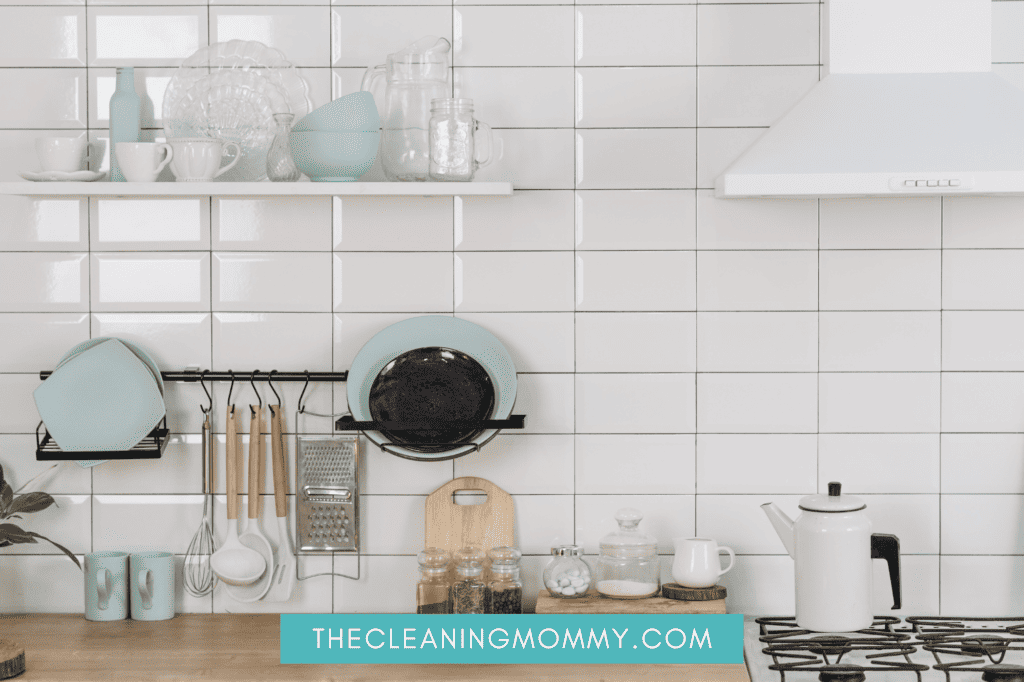
Types of Kitchen Tiles
When it comes to cleaning your kitchen tiles, it’s important to understand the difference between various materials you may have. The kitchen wall tiles, backsplashes and floor tiles may be different so you need to know how to properly maintain them for an attractive and functional kitchen space.
Ceramic and Porcelain Tile
Ceramic and porcelain tiles are popular choices for kitchen flooring and backsplashes because they are fairly low-maintenance, durable, and resist staining. They come in a wide range of colors, patterns, and sizes, allowing you to customize your kitchen’s appearance.
Ceramic tiles are made from clay that has been fired at high temperatures, resulting in a hard and dense material. These tiles are long-lasting and easy to clean, making them practical for a busy kitchen.
Porcelain tiles are like ceramic tiles but made with finer clay, fired at even higher temperatures. As a result, they are denser, more moisture-resistant, and often more durable than ceramic tiles. This makes porcelain tiles an excellent choice for high-traffic areas in your kitchen.
To clean ceramic and porcelain tiles, you can simply use a mixture of water and a mild detergent or a vinegar solution. It’s best to use a soft-bristle brush or microfiber mop to scrub the surfaces gently to avoid causing scratches or other damage.
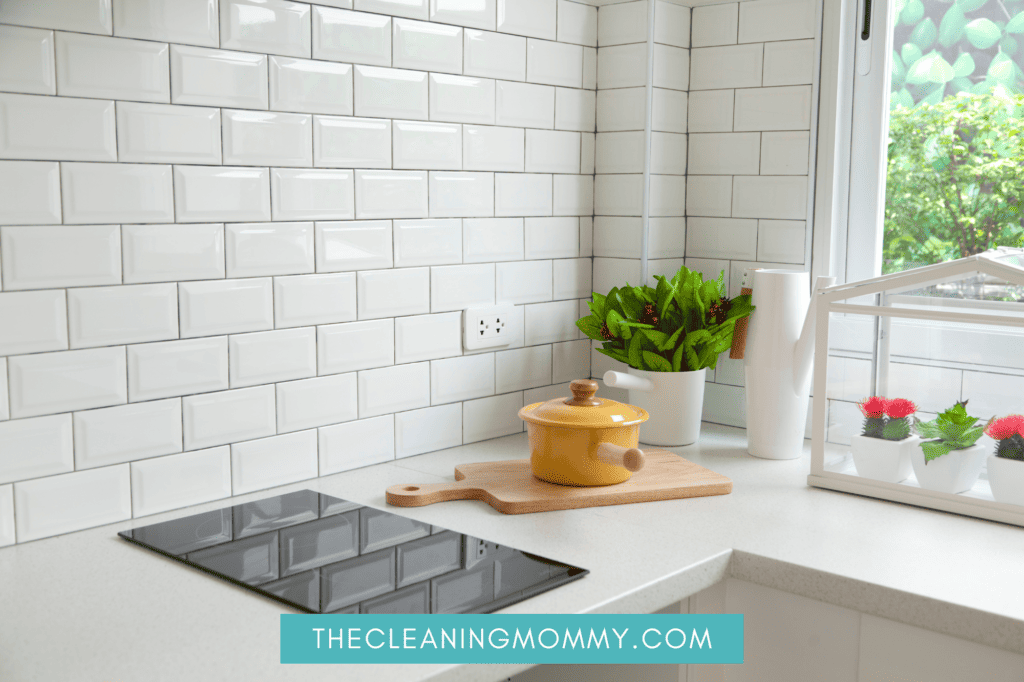
Natural Stone Tile
Natural stone tiles, such as slate, marble, granite, and limestone, are unique and beautiful options for backsplashes and kitchen floors. Each type of stone requires individualized care and often specific cleaners to properly maintain them.
Slate is a durable, slip-resistant material that comes in various earthy shades and textures. However, it may require regular sealing to prevent stains and moisture penetration.
Marble is an elegant choice but can be quite porous, making it susceptible to stains if not properly sealed. It can also be prone to chipping and scratching.
Granite is a strong and durable option that resists staining when sealed properly. It’s available in a wide range of colors and patterns.
Limestone is a softer, more porous stone that requires regular sealing and gentle cleaning to avoid damage.
For natural stone tiles, it’s essential to research the proper care and cleaning methods specific to the type of stone you have in your kitchen. Always avoid using harsh or acidic cleaners on these surfaces.
Linoleum and Resilient Floor
Linoleum and other resilient floor materials, like vinyl and rubber tiles, are affordable and low-maintenance alternatives to traditional kitchen tiles. These materials are easy to clean and can withstand heavy foot traffic and spills.
Linoleum is made from natural materials, such as linseed oil, cork, and wood powder, making it an eco-friendly choice. It has a soft, cushiony feel and is available in various patterns and colors.
Vinyl and rubber tiles are made from synthetic materials and come in many designs. They are water-resistant and easy to clean with a damp mop and a mild detergent.
When considering these options, it’s crucial to select a high-quality product to ensure durability and long-lasting performance in your kitchen. Proper installation and regular maintenance are also key to maintaining your kitchen’s appearance and functionality.
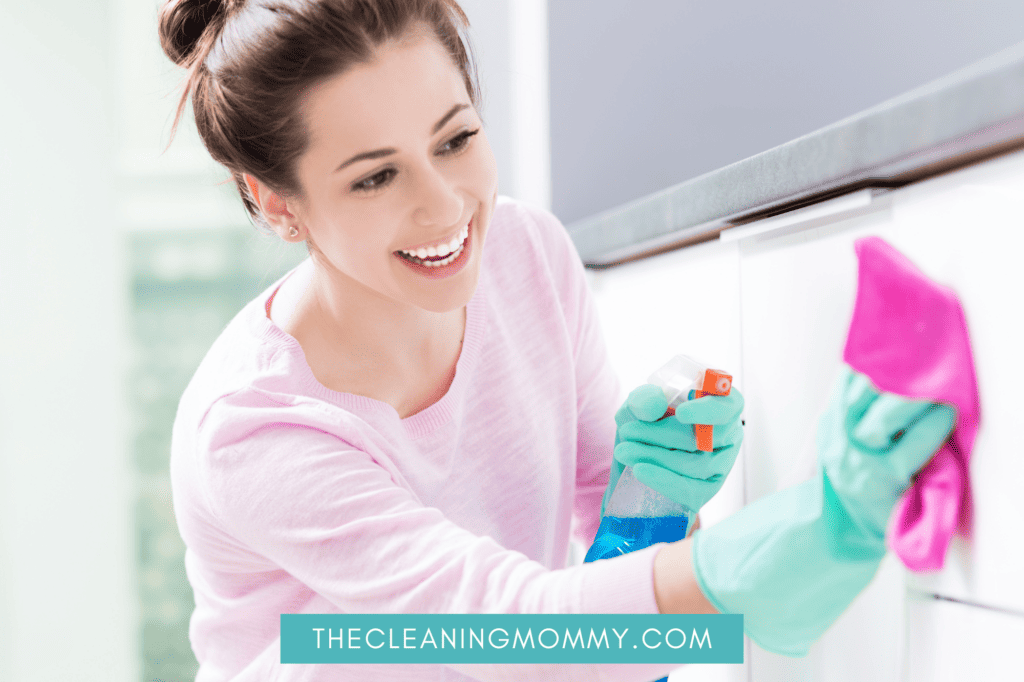
Basic Cleaning Methods
Sweeping and Vacuuming
Before you begin cleaning kitchen floor tiles, it’s important to remove dust, debris, and loose dirt from the surface. Start by sweeping the floor with a broom, focusing on the corners and areas where dirt tends to accumulate. Keep in mind that regular sweeping helps maintain your tiles and prevents buildup over time.
Once you’ve swept the area, you can use a vacuum cleaner with a tile or hard floor setting to remove any remaining dirt and debris. Ensure that you vacuum the entire floor surface, paying attention to the grout lines.
Mopping with Water and Mild Detergent
After sweeping and vacuuming, you can proceed to mop your kitchen tiles. This process not only removes stains and grime but also maintains the overall cleanliness of your kitchen floor. Follow these steps for mopping your tiles:
- Prepare the cleaning solution: In a bucket, mix warm water with a few drops of mild dish soap or a mild detergent. Ensure that the water is not too hot, as extreme temperatures can damage some tile surfaces.
- Select the right mop: For the best results, use a microfiber mop or a chamois-type mop to clean your kitchen tiles. These mops effectively pick up dirt without pushing it into the grout lines, making your cleaning process more efficient.
- Mop the floor: Dip the mop into the cleaning solution, and wring out any excess liquid. Mop your kitchen tiles, focusing on one section at a time. Be sure to rinse the mop frequently in the cleaning solution to avoid spreading dirty water across the floor.
- Dry the floor: After mopping, use a clean, dry towel or allow the floor to air dry. This step helps prevent streaks and water spots on your tiles, ensuring a clean and polished surface.
By following these basic cleaning methods and using the proper tools and techniques, you can keep your kitchen tiles looking fresh and well-maintained. Remember to sweep and vacuum regularly and mop with a water and mild detergent solution as needed to ensure the longevity and cleanliness of your tile surfaces.
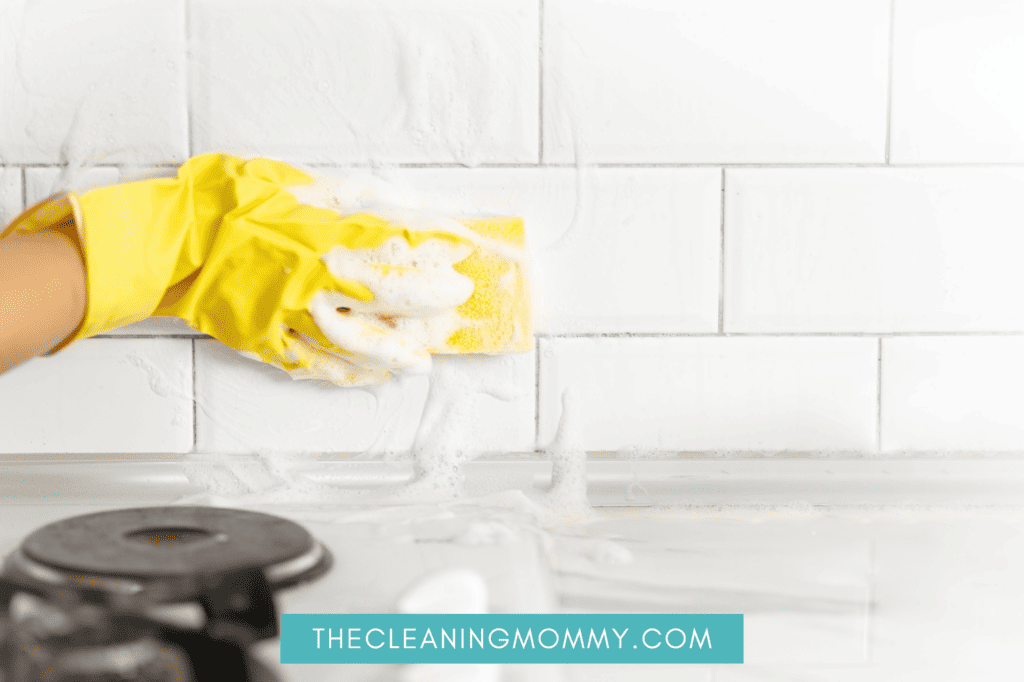
Deep Cleaning Techniques
Baking Soda and Vinegar Paste
To deep clean your kitchen tiles, use a baking soda and vinegar paste. Mix equal parts of baking soda and vinegar to form a paste. Apply the paste to the tiles with a sponge, focusing on areas with stubborn grime. Leave the paste on the tiles for 10-15 minutes, then scrub with a soft-bristle brush or gentle sponge. Rinse the tiles with hot water and a clean sponge to remove the paste residue.
Cleaning Grout Lines with Toothbrush
For the grout lines, an old toothbrush can be helpful for deep cleaning. Mix equal parts water and bleach in a small container to create a cleaning solution. Dip the toothbrush into the cleaning solution and gently scrub the grout lines. Be sure to avoid using abrasive cleaners, as they can damage your grout. Rinse the area with hot water and a clean sponge after scrubbing.
Degreaser for Greasy Messes
For greasy kitchen tiles, use a degreaser to remove stubborn stains. Find a degreaser that is safe for your specific tile material. Spray the degreaser onto the greasy spots and let it sit for a few minutes. Then, use a non-abrasive scrubbing brush to work the degreaser into the stained area. Wipe the area clean with a damp sponge and rinse with hot water.
Consider the following equipment and cleaning solutions when using a degreaser:
- Degreaser: Choose a product that is designed specifically for kitchen tiles.
- Scrubbing brush: Opt for a non-abrasive brush to avoid scratching your tiles.
- Damp sponge: Use to remove the degreaser and any remaining grime.
- Hot water: Rinse the tiles with hot water after using the degreaser.
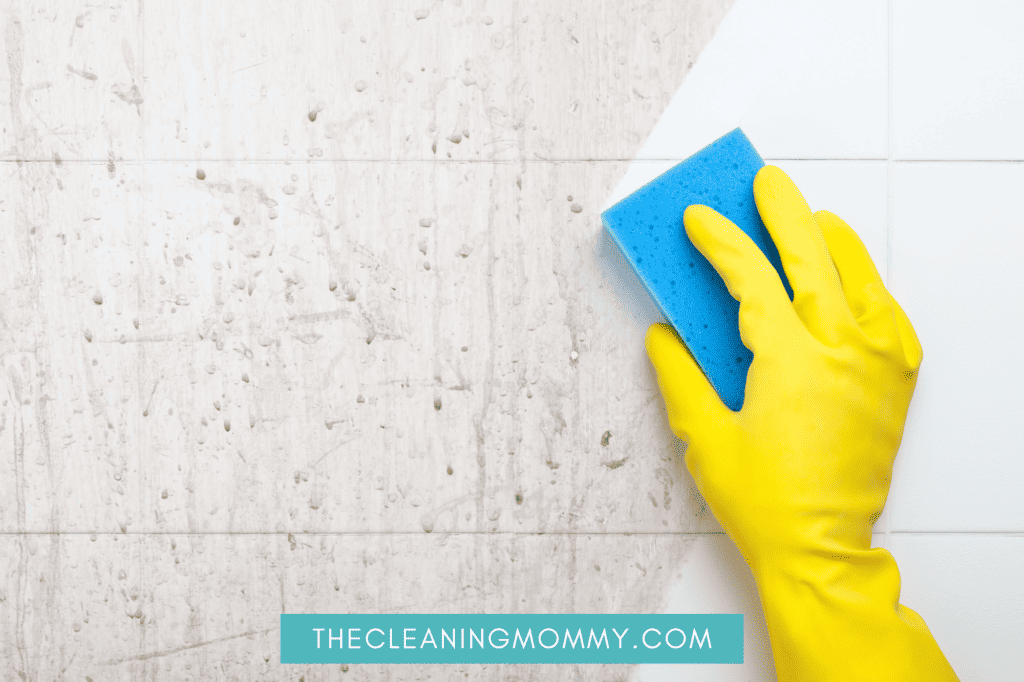
Steam Cleaning
Investing in a steam cleaner is an effective way to deep clean and sanitize your kitchen floors. This method is especially useful for cleaning large areas of tile quickly. Fill the steam cleaner with hot water and attach the appropriate cleaning accessory for your tiles.
Turn on the cleaner and begin steam cleaning your tiles and grout lines. The high-temperature steam will remove dirt, grime, and bacteria without the need for harsh chemicals.
Remember these tips for steam cleaning your kitchen tiles:
- Ensure your steam cleaner is appropriate for the type of tile you have.
- Test a small, inconspicuous area for colorfastness before steam cleaning the entire floor.
- Keep the steam cleaner moving to avoid damage from prolonged exposure to steam in one area.
- Wipe the area with a clean, dry microfiber cloth after steam cleaning to remove any remaining moisture.
Stain and Scratch Prevention
Cleaning Spills and Water Spots Promptly
To prevent stains and damage on your kitchen floor tiles, it is crucial to clean spills and water spots as soon as they occur. Prompt cleaning helps avoid the buildup of grime and reduces the risk of potential stains. Use a rag or a sponge mop to quickly absorb liquids like coffee, tea, or juice.
For water spots, wipe them down with a damp cloth and make sure to dry the area thoroughly afterward.
Using Non-Abrasive Cleaning Tools
Maintaining the durability of your kitchen floor tiles requires the use of non-abrasive cleaning tools. Opt for a soft bristle brush or sponge to clean your tiles gently. Avoid using harsh scrubbers that can cause scratches or damage the surface of the tiles, compromising their appearance and longevity.
Stick to gentle cleaning methods and solutions to ensure your tiles remain in excellent condition for years to come.

Regular Grout Sealing
Regularly sealing your kitchen grouting is a vital step in protecting your kitchen floor tiles from stains and damage and will make a huge difference in how your tile looks over time. Apply a grout sealer to the grout lines every six to twelve months, depending on the manufacturer’s recommendations. This process helps to:
- Keep the grout looking clean and fresh
- Prevent moisture absorption
- Reduce the risk of stains and discoloration
By following these simple steps, you can ensure the longevity and pristine appearance of your clean kitchen floor tiles.
Additional Cleaning Tips
Cleaning Countertops and Backsplashes
When cleaning kitchen countertops and backsplashes, it’s essential to use the right techniques and products. To start, remove any loose debris and wipe the surfaces with a damp cloth. Then, spray your countertops and backsplashes with an all-purpose cleaner.
If needed, sprinkle a bit of baking soda on top of the cleaner to add an extra cleaning power. Use a non-abrasive brush or sponge to work the mixture in gently and let it sit for about 10-15 minutes. Afterward, rinse the surfaces with warm water, and then use a clean, dry cloth to dry them.
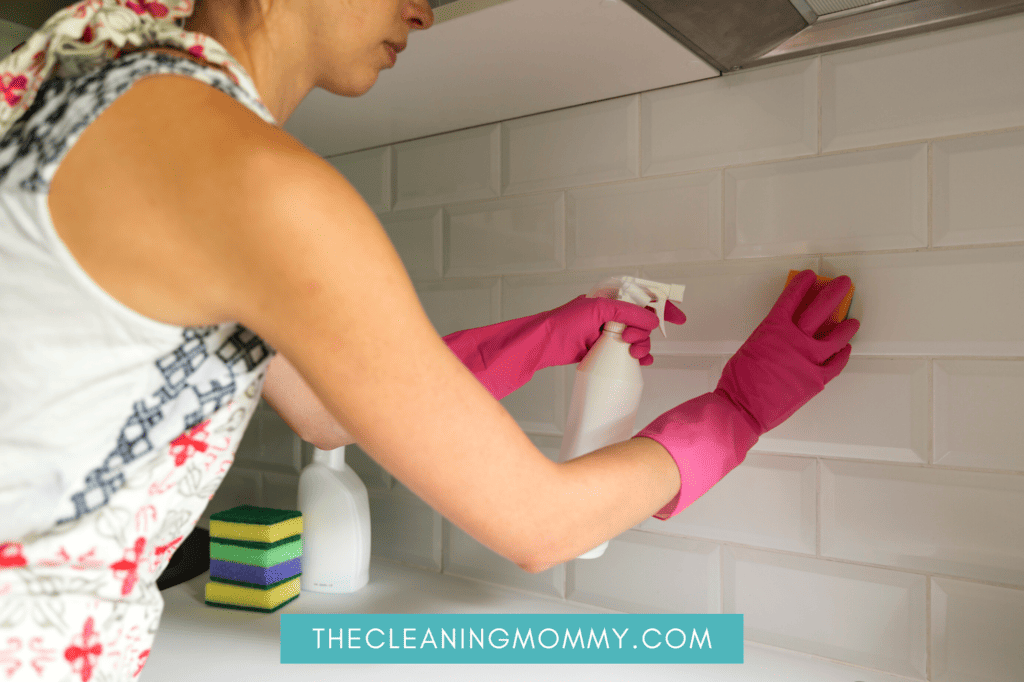
Safe Cleaning Solutions for Different Tile Types
Different types of tiles require specific cleaning solutions to maintain their appearance and avoid damage. Here’s a quick guide to clean kitchen wall tiles of various types:
- Ceramic tiles: To clean ceramic tiles, use a mild detergent mixed with clean water and a clean cloth. A chamois-type or microfiber cloth is preferable to a sponge, as it helps prevent the spread of dirt.
- Porcelain tiles: For porcelain tiles, you can use a vinegar solution consisting of one part water and one part white vinegar. Alternatively, use a pH-neutral cleaning solution.
- Glass tiles: Clean glass tiles with a glass cleaner or a solution of equal parts water and white vinegar.
- Natural stone tiles: For natural stone tiles, avoid acidic and abrasive cleaners. Instead, use gentle soap and water or specialized stone care products.
Dos and Don’ts for Kitchen Tile Care
To prolong the life of your kitchen tiles and keep them in pristine condition, follow these important dos and don’ts:
- Do sweep or vacuum your tile floors regularly to prevent dirt and debris buildup.
- Do clean countertops and backsplashes with appropriate cleaning solutions to maintain their appearance and prevent damage.
- Do clean up spills immediately to minimize the risk of stains and damage.
- Do test any new cleaning product on a small, inconspicuous area before applying it to the entire tile surface.
- Do clean your floors at least once a week.
- Don’t scrub tiles with abrasive brushes or sponges, as this can damage the surface and cause scratches.
- Don’t mix bleach with other cleaning products, as this can produce harmful fumes.
- Don’t use steel wool or scouring pads on kitchen tiles, as they can cause damage or scratches.
By following these helpful tips and choosing the right cleaning products, you can keep your kitchen tiles looking fresh and clean.
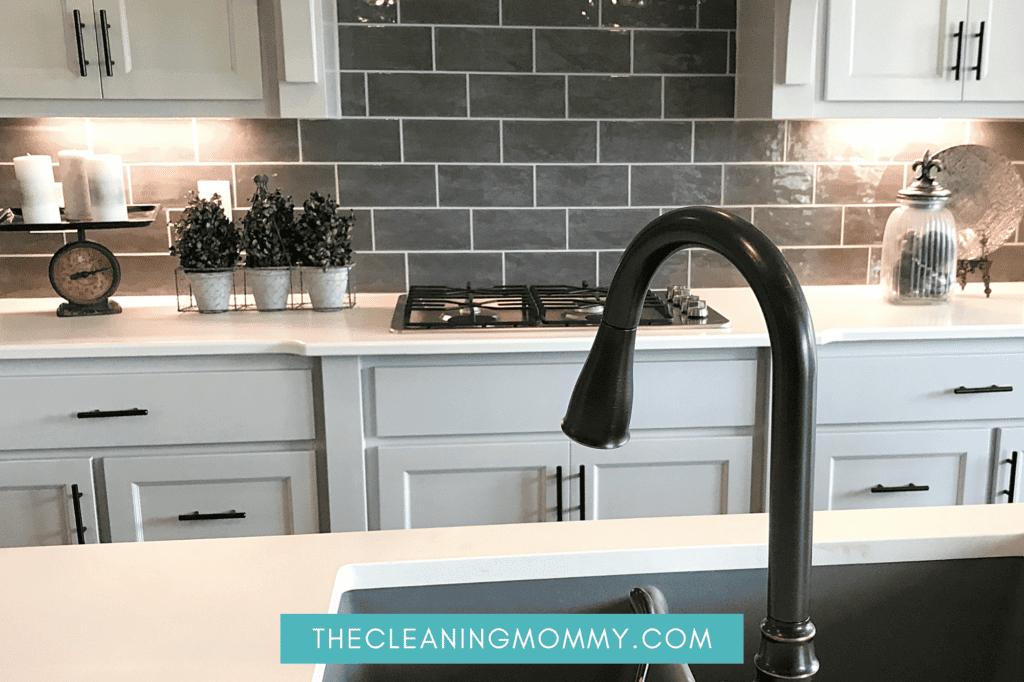
Frequently Asked Questions
What is the best way to remove grease stains?
To effectively remove grease and other tough stains from your kitchen tiles, use a heavy-duty degreaser like Elbow Grease or a similar product. Apply the cleaner with a non-scratch scrubby, focusing on areas with grease buildup. Rinse with warm water and a cloth to remove the degreaser and any remaining residue. More stubborn stains may require repeated attempts.
What is an easy DIY natural cleaning solution?
For a quick and easy way to clean wall tiles, use a 1:1 mixture of vinegar and water in a spray bottle. If you prefer, you can add a few drops of essential oil for a pleasant scent. Spray the solution on the tiles and wipe clean with a damp cloth or reusable paper towel.
If your tiles are unsealed, use 1 teaspoon of castile soap instead of vinegar. This is a simple natural cleaning agent that will take care of most tile cleaning.
What is the best way to clean kitchen tile grout?
Keep your tile grout looking fresh by cleaning it regularly with a soft bristle brush and grout cleaner. If you prefer a homemade solution, combine equal parts water and baking soda to form a paste. Apply the paste to the grout lines, let it sit for a few minutes, and then scrub with the brush. Rinse thoroughly with clean water and you should have perfectly clean grout.
What are some effective cleaning sprays?
When choosing a cleaning spray for your kitchen tiles, look for a product labeled as an all-purpose cleaner or one specifically designed for tile surfaces. Fantastic and Awesome are 2 very good general cleaners. Alternatively, you can create your own cleaning spray with a 1:1 mixture of water and vinegar in a spray bottle.
What are the top kitchen tile cleaners?
Some popular kitchen tile cleaning products include those from well-established brands such as Method, CLR, and Lysol. Be sure to read the label carefully to ensure the product is suitable for your tile type and follow the manufacturer’s instructions for best results. Cleaning tiles with these cleaners is easy- simply spray and wipe away with a clean soft cloth.
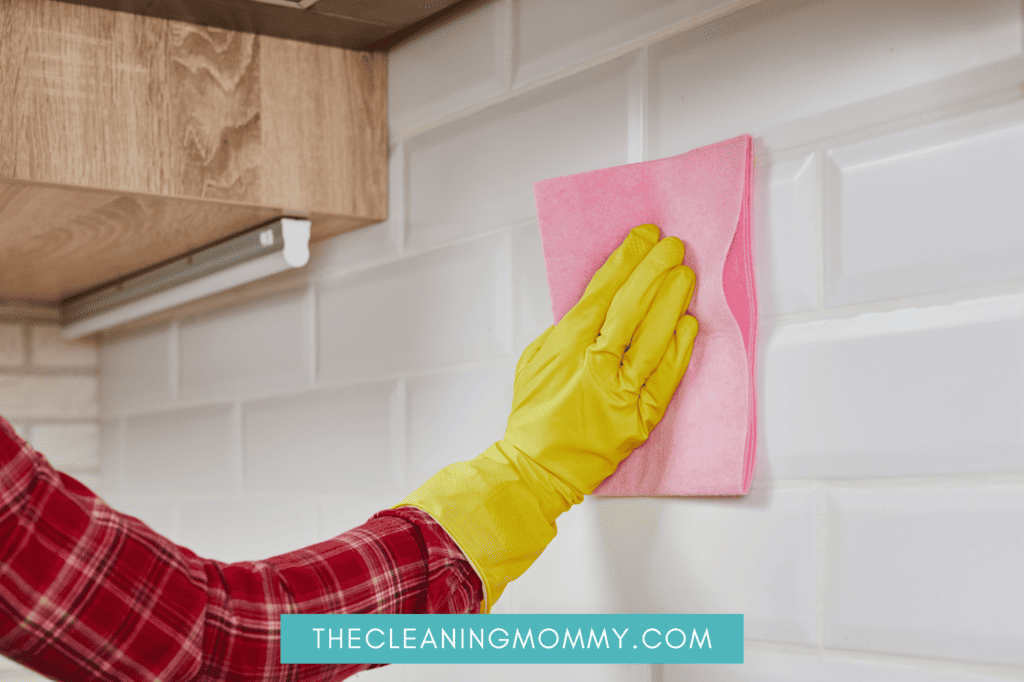
How do I maintain a clean backsplash?
To maintain a clean backsplash, make a habit of wiping down the surface regularly, especially after cooking. Use a soft, damp cloth or reusable paper towel with a gentle cleaner like diluted vinegar or mild detergent.
For stubborn stains or built-up grease, spot clean with a non-scratch scrubby and a heavy-duty degreaser. Avoid harsh cleaners like scouring powder when
Other Cleaning Articles You May Like:
- How To Clean Electric Stove Top
- How To Clean Walls Fast And Easy
- How To Clean Window Sills
- Window Sill Cleaning Hacks
- How to clean terracotta tiles
- Best way to clean silicone molds
- Best way to clean up fire extinguisher residue
- 18+ Common household items you are forgetting to replace
- How to easily get rid of the smell in your refrigerator
- How to make your own eyeglass cleaner

Grainne Foley
Grainne Foley is a wife and mother of 2 great kids. During her 5 years of full time RV travel, Grainne learned to become very efficient at household chores, in order to make time for family adventures. Now, back in a house, she has continued to create tools and techniques to help others lighten the load of household organization and cleaning.
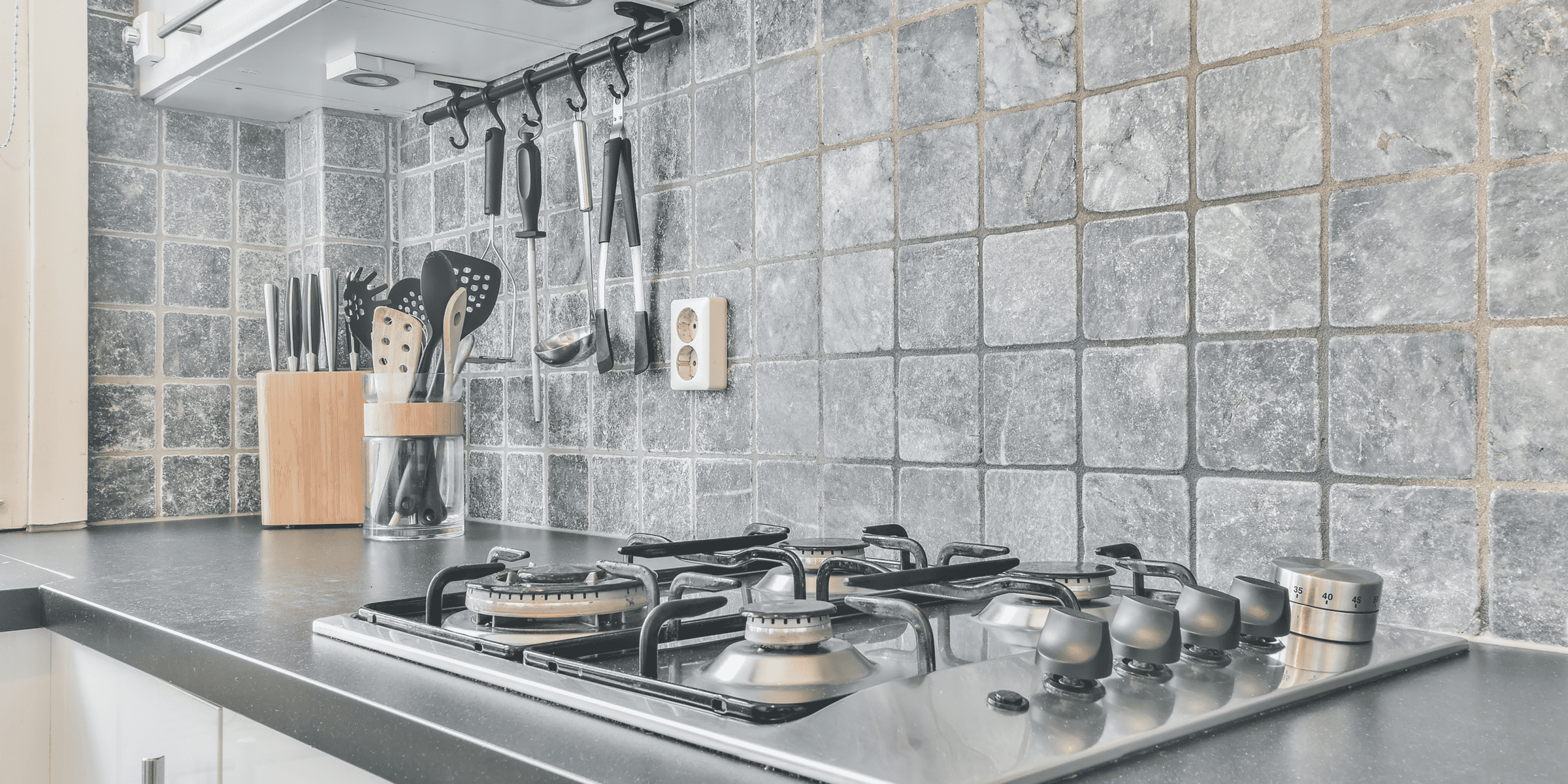


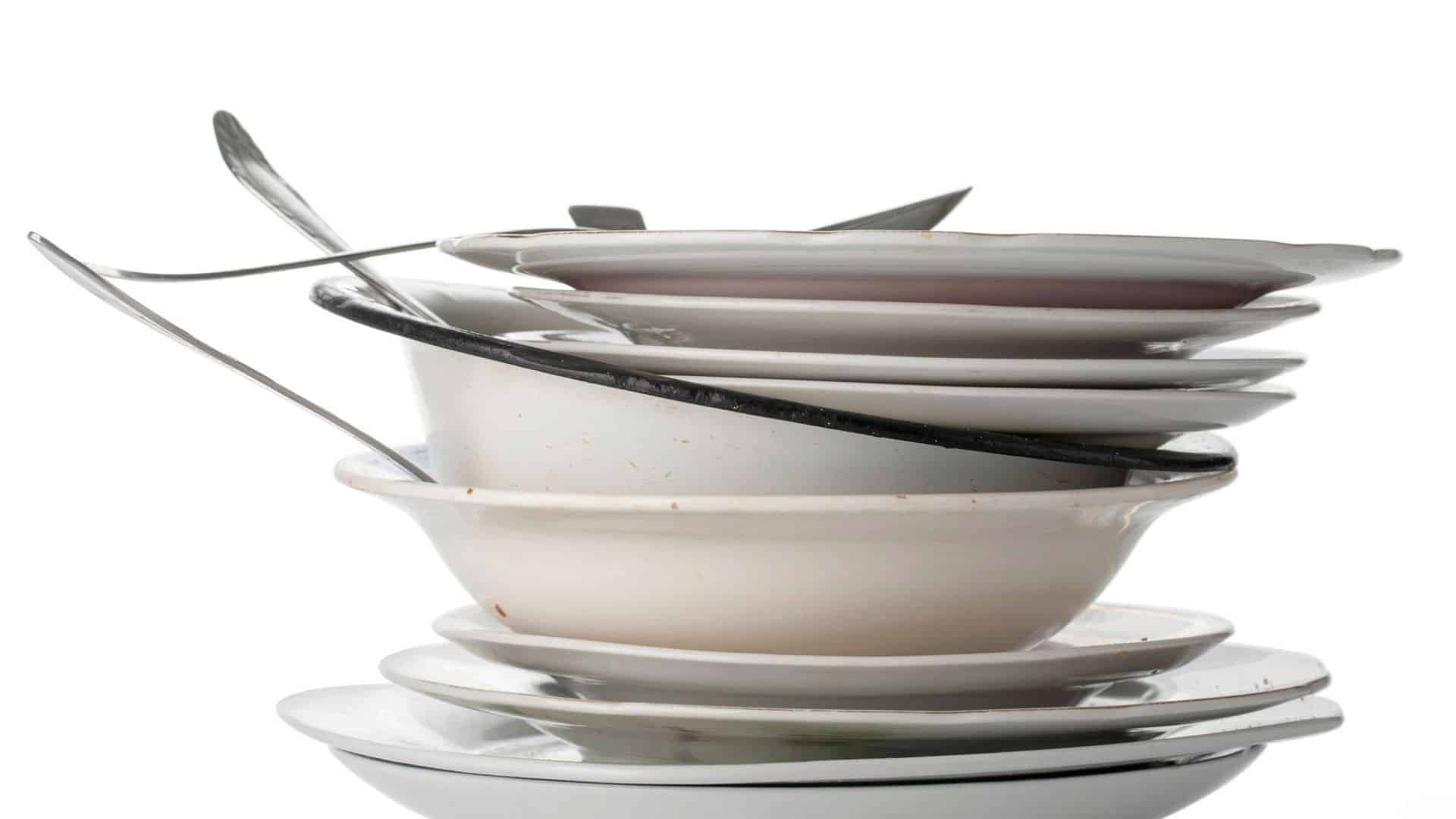

Leave a Reply